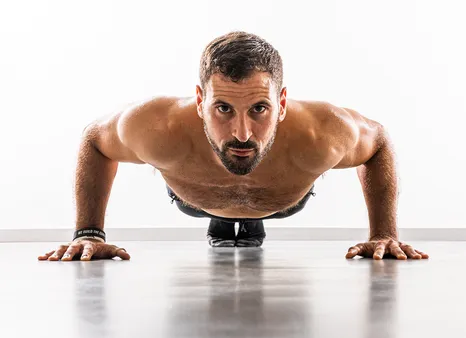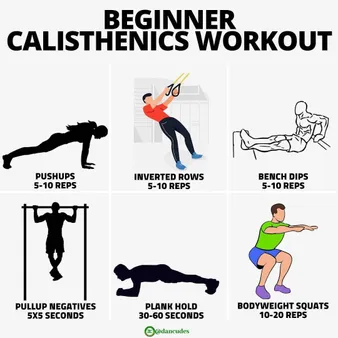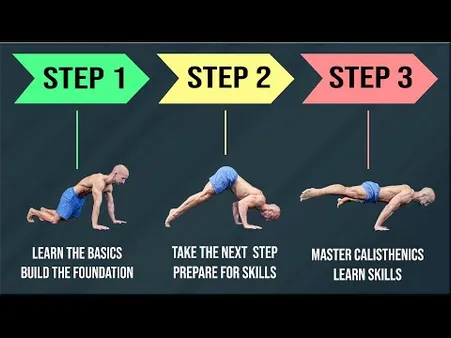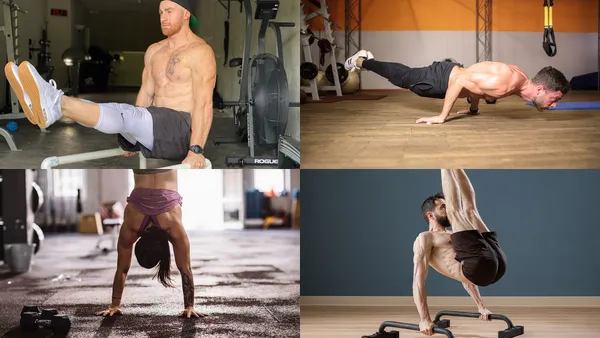Table of Contents
Exercise shouldn't be a chore and learning the ways of calisthenics just might change the way you see physical fitness. This form of bodyweight training has a lot of awesome benefits, so it's definitely worth learning and trying for yourself. If you want to know how you can learn calisthenics, then you're in the right place. Kizworld has put together this guide to help you start learning this new and fun skill!
Get Ripped with Exciting Calisthenics Exercises: A Comprehensive Guide to Learn Calisthenics
Topic | Key Takeaway |
|---|---|
What is Calisthenics? | Calisthenics is a bodyweight training method that uses exercises like push-ups, pull-ups, and squats to build strength, flexibility, and endurance. |
Benefits of Calisthenics | Calisthenics offers numerous benefits, including improved strength, flexibility, endurance, coordination, and balance. |
How to Get Started with Calisthenics | Start with basic exercises like push-ups, squats, and lunges. Gradually increase the difficulty and intensity as you progress. |
Calisthenics Exercises for Beginners | Beginner-friendly exercises include bodyweight squats, push-ups on knees, and assisted pull-ups. |
Calisthenics Workouts for All Levels | Design workouts based on your fitness level, starting with beginner routines and progressing to advanced exercises. |
Tips for Progressing in Calisthenics | Set realistic goals, focus on proper form, and incorporate progressive overload to challenge yourself. |
Common Mistakes to Avoid in Calisthenics | Avoid overtraining, neglecting flexibility, and using improper form, which can lead to injuries. |
Nutrition for Calisthenics | Fuel your body with a balanced diet rich in protein, carbohydrates, and healthy fats. |
Supplements for Calisthenics | Consider supplements like creatine, protein powder, and BCAAs to support muscle growth and recovery. |
Calisthenics Community and Resources | Join online forums, follow calisthenics influencers, and attend workshops to connect with the community and learn from others. |
I. Calisthenics: A Comprehensive Guide to Getting Started
What is Calisthenics?
Calisthenics is a form of bodyweight training that uses exercises like push-ups, pull-ups, and squats to build strength, flexibility, and endurance. It's a great way to get in shape without having to go to a gym or buy expensive equipment.
Benefits of Calisthenics
There are many benefits to calisthenics, including:
- Improved strength
- Increased flexibility
- Enhanced endurance
- Improved coordination
- Increased balance
Exercise | Difficulty | Benefits |
|---|---|---|
Push-ups | Beginner | Strengthens chest, shoulders, and triceps |
Pull-ups | Intermediate | Strengthens back, biceps, and forearms |
Squats | Beginner | Strengthens legs and glutes |
How to Get Started with Calisthenics
If you're new to calisthenics, start with some basic exercises like push-ups, squats, and lunges. You can find plenty of beginner-friendly calisthenics workouts online or in books. As you progress, you can gradually increase the difficulty and intensity of your workouts. Here's a beginner's guide to calisthenics to help you get started.
Calisthenics: A Comprehensive Guide to Getting Started
II. Mastering the Basics: Essential Exercises for Beginners
Bodyweight Squats: A Foundation for Strength
Bodyweight squats are a fundamental exercise for building lower body strength and mobility. Start with your feet shoulder-width apart, lower your body by bending your knees and hips, as if sitting back into a chair. Keep your chest up and your knees aligned with your toes. Return to the starting position by extending your legs. Aim for 10-15 repetitions.Learn more about squats
Push-Ups on Knees: Modified for Accessibility
Push-ups on knees are a modified version of the classic push-up, making it accessible for beginners. Start in a plank position with your hands shoulder-width apart and your knees on the ground. Lower your chest towards the ground by bending your elbows, then push back up to the starting position. Aim for 8-12 repetitions.Discover the benefits of push-ups
Assisted Pull-Ups: Building Upper Body Strength
Assisted pull-ups are a great way to develop upper body strength, especially for those new to pull-ups. Use a resistance band or assisted pull-up machine to reduce the weight you're lifting. Grip the bar with your hands shoulder-width apart, pull yourself up until your chin reaches the bar, then slowly lower back down. Aim for 6-10 repetitions.Master the art of pull-ups
Exercise | Benefits |
|---|---|
Bodyweight Squats | Builds lower body strength and mobility |
Push-Ups on Knees | Modified push-up for beginners, accessible and effective |
Assisted Pull-Ups | Develops upper body strength, especially for beginners |
These exercises provide a solid foundation for calisthenics, helping you build strength, flexibility, and coordination. Remember to start gradually, listen to your body, and enjoy the journey of mastering calisthenics.
Mastering the Basics: Essential Exercises for Beginners
III. Advanced Calisthenics: Pushing Your Limits
Mastering Complex Movements
As you progress in your calisthenics journey, you'll naturally gravitate towards more challenging exercises. These advanced movements require greater strength, coordination, and flexibility. Some popular examples include the muscle-up, planche, and human flag. Mastering these exercises not only looks impressive but also significantly enhances your overall physical capabilities.Check out our guide on how to master the muscle-up
Progressive Overload and Skill Development
To continually push your limits in calisthenics, progressive overload is key. This means gradually increasing the difficulty of your workouts over time. You can achieve this by adding weight, reps, sets, or exercise variations. As you progress, you'll also need to focus on developing specific skills, such as handstands, levers, and dynamic movements.Learn the basic calisthenics skills and progressions
Injury Prevention and Recovery
As you venture into advanced calisthenics, it's crucial to prioritize injury prevention. Proper warm-ups, cool-downs, and rest days are essential. Additionally, pay attention to your body's signals and take breaks when needed. Recovery is just as important as training, so ensure you get adequate sleep, nutrition, and hydration.
Exercise | Difficulty | Benefits |
|---|---|---|
Muscle-up | Advanced | Builds upper body strength, coordination, and explosiveness |
Planche | Extreme | Develops incredible core strength, shoulder stability, and balance |
Human Flag | Extreme | Requires immense grip strength, core control, and flexibility |
Advanced Calisthenics Workouts
Designing effective advanced calisthenics workouts requires careful planning. Consider your current fitness level, goals, and available equipment. Start with a solid foundation of basic exercises and gradually incorporate more challenging variations. Remember to warm up properly, focus on proper form, and listen to your body.Get tips on designing your own calisthenics routine
Community and Inspiration
The calisthenics community is a valuable resource for support, motivation, and knowledge sharing. Connect with other enthusiasts online or at local parks and gyms. Follow experienced athletes on social media, attend workshops, and engage in discussions to stay inspired and learn from others.
- Join online calisthenics forums and groups
- Follow calisthenics influencers on social media
- Attend calisthenics workshops and events
Advanced Calisthenics: Pushing Your Limits
IV. Nutrition and Recovery: Fueling Your Calisthenics Journey
Proper nutrition and recovery are essential for maximizing your progress in calisthenics. A balanced diet rich in protein, carbohydrates, and healthy fats will provide the building blocks and energy your body needs to build muscle, repair tissue, and perform at its best. Here are some key nutritional considerations for calisthenics athletes:
Protein: Protein is essential for muscle growth and repair. Aim for 1.6-2.2 grams of protein per kilogram of body weight per day. Good protein sources include lean meats, poultry, fish, eggs, dairy products, and beans.
Carbohydrates: Carbohydrates provide energy for your workouts. Choose complex carbohydrates such as brown rice, quinoa, oatmeal, and whole-wheat bread over simple carbohydrates like sugary drinks and processed foods.
Healthy fats: Healthy fats support hormone production, cell function, and recovery. Include healthy fats in your diet from sources such as avocados, nuts, seeds, and olive oil.
Hydration: Staying hydrated is crucial for overall health and performance. Drink plenty of water throughout the day, especially before, during, and after workouts.
In addition to a balanced diet, consider supplementing with creatine, protein powder, and BCAAs to support muscle growth and recovery. Creatine is a natural substance that helps increase muscle strength and power. Protein powder can help you meet your daily protein needs, and BCAAs (branched-chain amino acids) can help reduce muscle soreness and promote recovery.
Getting enough rest is also essential for recovery. Aim for 7-9 hours of sleep per night. During sleep, your body repairs muscle tissue and replenishes energy stores.
By following these nutritional and recovery guidelines, you can optimize your body's ability to perform at its best in calisthenics and achieve your fitness goals.
Nutrient | Recommended Intake | Sources |
|---|---|---|
Protein | 1.6-2.2 grams per kilogram of body weight per day | Lean meats, poultry, fish, eggs, dairy products, beans |
Carbohydrates | 5-10 grams per kilogram of body weight per day | Brown rice, quinoa, oatmeal, whole-wheat bread |
Healthy fats | 20-35% of daily calories | Avocados, nuts, seeds, olive oil |
Related Posts:
- The Best Calisthenics Supplements and Nutrition
- How to Train Like a Calisthenics Pro
- The Most Common Calisthenics Mistakes and How to Fix Them
Nutrition and Recovery: Fueling Your Calisthenics Journey